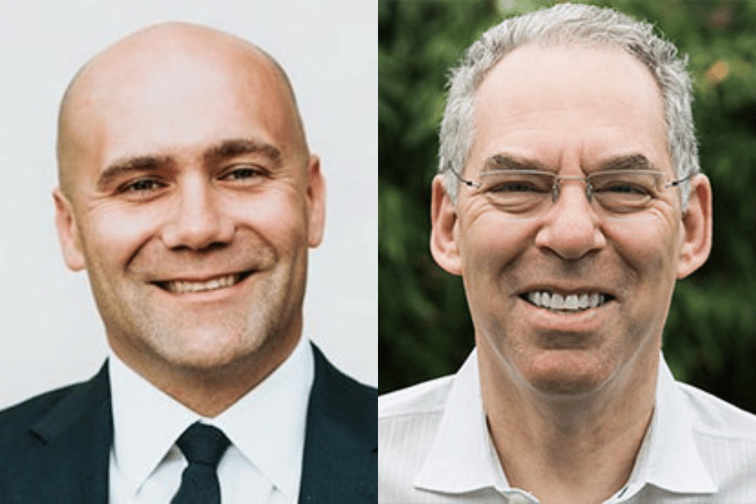

CEO Alex Martin (pictured above left) describes his AI voice analytics company Clearspeed as a “six-year overnight success.” The San Diego-based insurtech has quietly built its operations for years but only recently gained attention from investors and the insurance marketplace.
“It took a long time to get the technology right and to be able to back some of the claims we make … [and to] get people to try it in the insurance space,” Martin said in a Sept. 20 interview, during a break from the InsureTech Connect 2022 conference in Las Vegas.
The company launched in 2016, and currently has roughly 50 employees. It is hiring. Clearspeed has raised $50 million in total venture capital funding, including a $27 million round that closed earlier in September. Clearspeed reached its funding goal, but investor interest could have easily taken that number much higher, said Jules Ehrlich (pictured above right), Clearspeed’s chief product and strategy officer.
Clearspeed’s signature product, which has origins in the US military, relies on voice analytics technology that conducts automated risk assessments for the insurance industry. Target customers and users include insurance companies, third party administrators and special investigation units at carriers.
Clearspeed launched its product in 2021 and now has 50 total customers, including some “very large UK-based carriers,” Ehrlich said.
Beyond that, Ehrlich added, many customers are moving from pilot into production and others are “just starting their journey with us.”
Clearspeed has generated early customer interest, in part, because it helps boost claims processing time and quickens claims payments to insureds.
“We provide the ability for a claim to go straight through using a voice automated questionnaire,” Martin said. “You’re able to get paid with unprecedented speed, and, if you’re an insurer, you’re getting unprecedented accuracy for the fraud that’s being detected. That isn’t [happening] with legacy solutions.”
The need for a thorough-but-quicker way to process claims matters greatly to both insureds and the carriers who insure them, both men said.
“It’s speed with high assurance,” Ehrlich explained. “The key thing with our technology is that in a few minutes – and with greater than 97% accuracy – you can get the risk of a claim by just asking someone a few questions. Automatically, the insureds get their results. If that claim is low risk, that person can get paid in minutes, literally.”
Clearspeed’s technology is designed to deliver automated questionnaires.
“You’re replacing the need to fill out anything with pen and paper, and you’re replacing the need for that first contact view with a human [that’s] too expensive and prone to bias,” Martin said.
Early designs of the technology stemmed from the need to create “the inverse of a fraud detection tool,” Martin explained – a clearance tool for the US military that enabled questions to be asked without bias across language and cultures. He described that early version as “a metal detector using voice.”
The model was refined and revalidated over the years. In its current version, the software analyzes answers, which are converted into data, to spot quantifiable and measurable risk characteristics.
Martin said the software is configured to ask a series of ‘yes’ or ‘no’ questions, and then a series of open-ended questions everyone gets asked when they submit a claim.
“The responses that the person gives, ‘yes’ or ‘no’ or open-ended, carry artifacts that are low risk if the person is entering [responses] accurately,” Martin said. “If they’re inaccurate responses, we flag as not being a lie, but simply being anomalous … we are actually just trying to clear the low-risk response and alert the high risk” ones.
According to Martin, the software relies on signal processing techniques that convert speech to data that is then analyzed. The company has also developed scale to score responses that have been developed iteratively over time, and fined tuned in terms of accuracy and clearing low risk responses.
A set of algorithms also help pace the software’s analyses, Ehrlich noted.
“It isn’t this black box thing that runs and tries to learn,” Ehrlich said. “We essentially have a model of risk that we’ve developed over many years.”
In the future, he said, artificial intelligence and other types of machine learning could be applied to speed the process and change the types of products the company offers, “but today, it’s not an essential part of what we do.”
Clearspeed connects to clients via APIs to allow them to access the software easily, and through the cloud. The company’s SaaS (software-as-a-service) model makes money per claim.
This is Clearspeed’s third year attending the ITC event, which was expected to attract 8,000 visitors – matching pre-pandemic levels. Martin said his company’s goal was to mingle with other entrepreneurs, show off the results Clearspeed has been getting, and make its case to potential partners.
“We augment and enhance, so we’d like to know what else is out there, partnership-wise,” Martin said.
